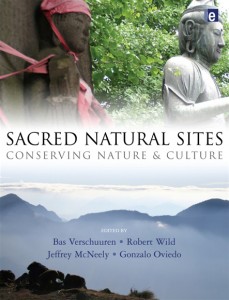
א נייַ בוך, הייליק נאַטוראַל זייטלעך: קאָנסערווינג נאַטור און קולטור, איז זייַענדיק לאָנטשט דורך יוקן הייַנט בייַ די קאַנווענשאַן אויף ביאָלאָגיקאַל דיווערסיטי זיצונג אין נאַגויאַ, דזשאַפּאַן. דער קאַטער איז אַ טייל פון אַ געשעעניש אָרגאַניזירט דורך אַ מיטאַרבעט צווישן עטק-Compas און יוקן און איז דעדאַקייטאַד צו פּראַמאָוטינג הייליק נאַטירלעך זייטלעך און זייער קריטיש ראָלע אין קאָנסערווינג נאַטור און קולטור. דער בוך איז באזירט אויף דערפאַרונג פון אַרום די וועלט וואָס כיילייץ די וויכטיקייט פון הייליק נאַטירלעך זייטלעך אין בייאָודייווערסאַטי קאַנסערוויישאַן און די לאַנג-שטייענדיק באציונגען צווישן נאַטור און מענטשן.
הייליק נאַטירלעך זייטלעך אַרייַננעמען געביטן אנערקענט ווי הייליק דורך ינדידזשאַנאַס און בעקאַבאָלעדיק פעלקער און געביטן אנערקענט דורך רעליגיאָנס אָדער פייטס ווי ערטער פֿאַר דינען און דערמאָנונג. They are the world’s oldest conservation areas and contain high levels of biological and cultural diversity. זיי באַשיצן אַ ברייט פאַרשיידנקייַט פון כאַבאַטאַץ, היטן בעקאַבאָלעדיק מינהגים, practices and knowledge related to biodiversity conservation and promote mutual respect between people and nature.
But today this global natural and social conservation network is not sufficiently understood or recognized. עס איז אונטער-פאַנדאַד און ינקריסינגגלי אונטער סאַקאָנע. ווי מיר תמיד העכערן אַנטוויקלונג בייַ די קאָסט פון די נאַטירלעך וועלט, we are destroying these sites through ignorance, overconsumption and overexploitation of resources. We are also largely unaware of their significance in maintaining and restoring meaningful and sustainable relationships between humans and nature.
“Sacred natural sites provide for the protection of biodiversity but also for the continuation of cultural practices,” says באַס ווערסטשוורען, Co-chair of IUCN’s Specialist Group on Cultural and Spiritual Values of Protected Areas and programme coordinator with ETC-COMPASand lead editor of the book. “As most of the threats that sacred natural sites face today, such as tourism, industrialization and urbanization, affect both cultural and biological values, they weaken the special relationship between people and nature that is so typical to these areas and so precious not only to many cultures around the world but also to humanity as a whole.”
Other editors of the book include Robert G. ווילד, Chair of the IUCN’s Specialist Group on Cultural and Spiritual Values of Protected Areas, Jeffrey A. מאַקנילי, IUCN’s Senior Science Advisor אוןGonzalo Oviedo IUCN Senior Advisor for Social Policy. The book contains 27 chapters contributed by 55 authors which focus on a wide geographical spread of both iconic and lesser known examples of sacred natural sites. These sites exist in and outside protected areas or other designated areas and include the sacred groves of the Western Ghats (ינדיאַ), the sacred mountains of Sagarmatha /Chomolongma (מט עווערעסט, נעפּאַל, טיבעט – און טשיינאַ), די גאָלדען בערג פון אַלטאַי (רוסלאַנד) and the Holy Island of Lindisfarne (וק) און די הייליק לאַקעס פון די ניגער דעלטאַ (ניגעריאַ).
“Networks of sacred natural sites are found in every country,” says Jeff McNeely. “Many of them are hotspots of biocultural diversity. Although The Convention on Biological Diversity recognizes their importance, the need for greater recognition, conservation and restoration should be made more explicit.”
The authors also highlight the need to recognize the crucial role that custodians of these areas play in the protection of their natural and cultural diversity.
“Custodians of sacred natural sites bear unique responsibilities within local, indigenous and religious communities.” says גאָנזאַלאָ אָוויעדאָ. “They play a vital role in the governance of their community and their relationship with the earth. They have some unique knowledge of cultural and spiritual practices, traditional medicine, livestock breeding and agricultural cycles. They contribute to universal values that maintain people’s relationships with the earth.”
יוקן, through its Specialist Group on Cultural and Spiritual Values of Protected Areas, is actively engaged in helping to protect these sites. But much more still needs to be done.
“We would like to see better management of these areas that recognize and respect the sound conservation knowledge of custodians and communities,. This requires support from policy makers, conservation experts, lawyers and academics,” says ראבערט ווילד. “Improved understanding and greater public awareness of the biological and cultural values of these sites are also necessary if we want to preserve these precious examples of our planet’s bio-cultural diversity. Further sacred natural sites provide models of the deepest ethical relationships of humanity with nature, critical signposts for all of us given the serious global challenges humanity is facing.”
The Convention on Biological Diversity started to recognize the importance of sacred sites when it issued the אַקווé: Kon Voluntary Guidelines for Impact Assessment in Sacred Sites אין 2004. The Conference of the Parties is currently discussing the CBD Programme of Work on Protected Areas, which – although not explicitly addressing sacred natural sites – offers opportunities for action to protect them. The Conference is also considering a proposed programme of work on cultural diversity jointly with UNESCO, where sacred sites may become an important topic. IUCN is calling the CBD parties to give more attention to sacred sites through these and other programmes and measures.
 פֿאַר מער אינפֿאָרמאַציע, ביטע קאָנטאַקט:
פֿאַר מער אינפֿאָרמאַציע, ביטע קאָנטאַקט:
גאָנזאַלאָ אָוויעדאָ
IUCN’s Senior Adviser, Social Policy
בליצפּאָסט: gonzalo.oviedo@iucn.org
tel. +81 (0) 80 10 03 40 67
באַס ווערסטשוורען
Co-chair of IUCN’s Specialist Group on
Cultural and Spiritual Values of Protected Areas
בליצפּאָסט: basverschuuren@gmail.com
מאָקער: iucn.org






